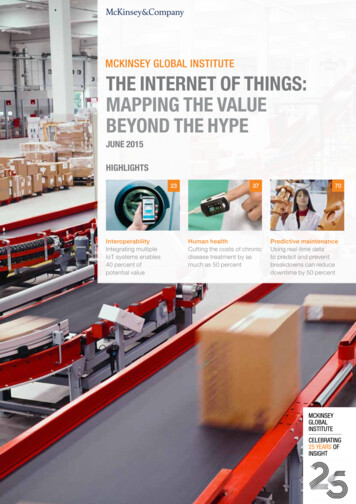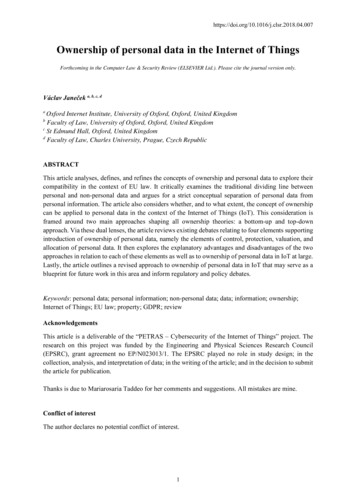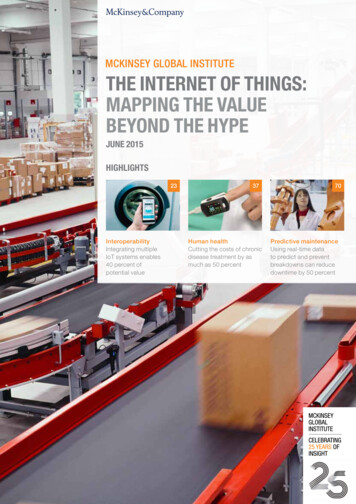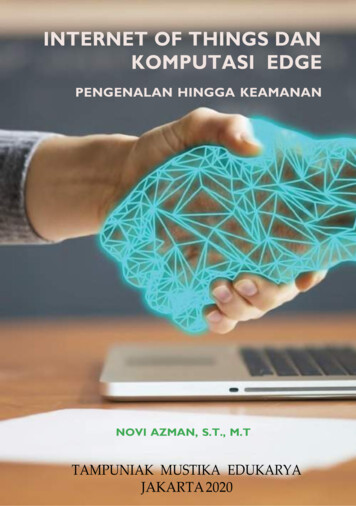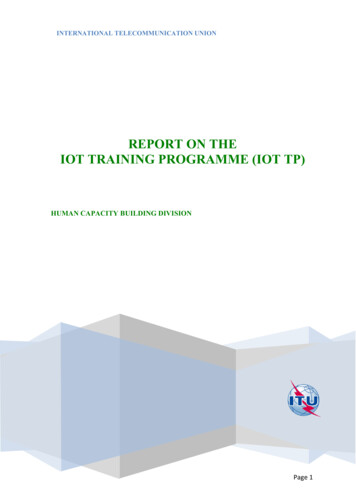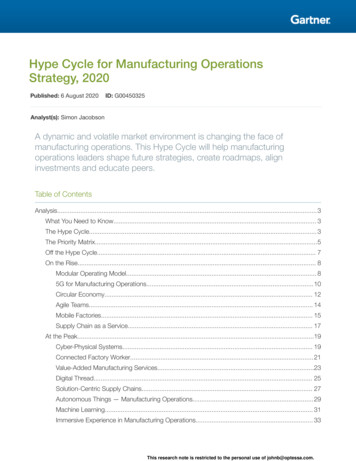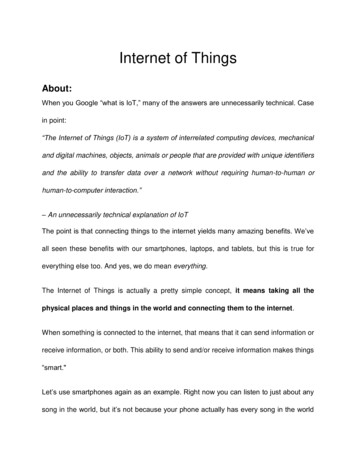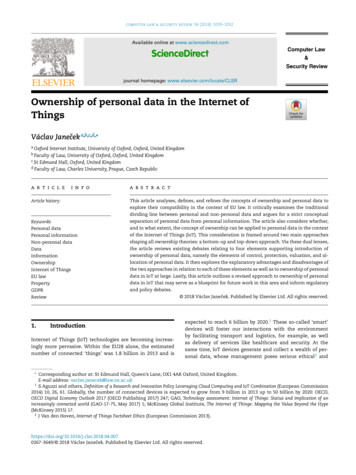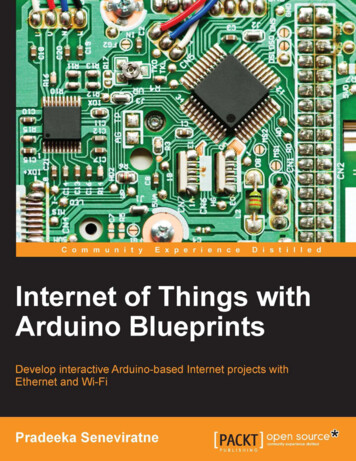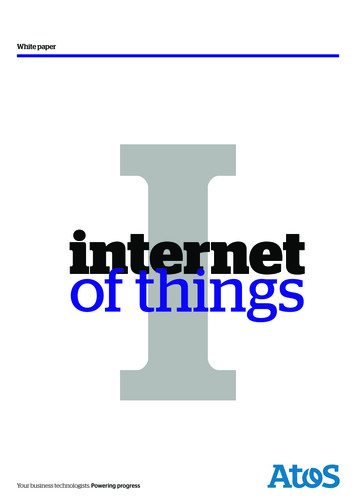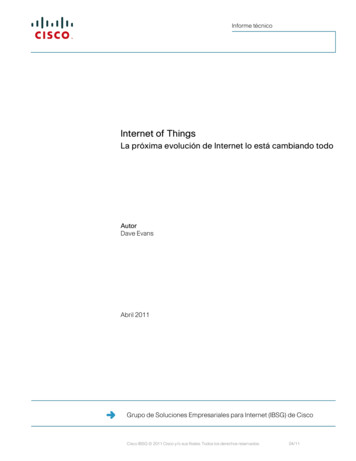
Transcription
Ammar RayesSamer SalamInternet of ThingsFrom Hype to RealityThe Road to DigitizationSecond Edition
Internet of Things From Hype to Reality
Ammar Rayes Samer SalamInternet of Things FromHype to RealityThe Road to DigitizationSecond Edition
Ammar RayesSan Jose, CA, USASamer SalamBeirut, LebanonISBN 978-3-319-99515-1ISBN -99516-8(eBook)Library of Congress Control Number: 2018955510 Springer Nature Switzerland AG 2017, 2019This work is subject to copyright. All rights are reserved by the Publisher, whether the whole or part ofthe material is concerned, specifically the rights of translation, reprinting, reuse of illustrations, recitation,broadcasting, reproduction on microfilms or in any other physical way, and transmission or informationstorage and retrieval, electronic adaptation, computer software, or by similar or dissimilar methodologynow known or hereafter developed.The use of general descriptive names, registered names, trademarks, service marks, etc. in this publicationdoes not imply, even in the absence of a specific statement, that such names are exempt from the relevantprotective laws and regulations and therefore free for general use.The publisher, the authors, and the editors are safe to assume that the advice and information in this bookare believed to be true and accurate at the date of publication. Neither the publisher nor the authors or theeditors give a warranty, express or implied, with respect to the material contained herein or for any errorsor omissions that may have been made. The publisher remains neutral with regard to jurisdictional claimsin published maps and institutional affiliations.This Springer imprint is published by the registered company Springer Nature Switzerland AGThe registered company address is: Gewerbestrasse 11, 6330 Cham, Switzerland
To invent, you need a good imagination anda pile of junk.– Thomas A. EdisonTo invent, you need the Internet,communication, good imagination and a pileof things.– Ammar RayesCreativity is just connecting things. Whenyou ask creative people how they didsomething, they feel a little guilty becausethey didn’t really do it, they just sawsomething. It seemed obvious to them after awhile. That’s because they were able toconnect experiences they’ve had andsynthesize new things.– Steve JobsHow the Internet of Things will bend andmold the IP hourglass in the decades to comewill certainly be fascinating to witness. We,as engineers, developers, researchers,business leaders, consumers and humanbeings are in the vortex of thistransformation.– Samer Salam
Foreword 1In California, just a few months after two people stepped foot on the Moon for thefirst time, two computers began sending messages to each other using protocolsdesigned to make it easy for other computers to connect and join the party (Leineret al. 2009). On October 29, 1969, a computer in Leonard Kleinrock’s lab at UCLAand a computer in Doug Engelbart’s lab at SRI forged the first two nodes in whatwould become known as the Internet. Vint Cerf and two colleagues coined the termInternet as a shortened version of internetworking in December 1974. It did not takelong for more computers and their peripherals, as well as more networks of computers, and even industrial equipment to connect and begin communicating messages,including sharing sensor data and remote control instructions. In early 1982, a sodamachine at CMU became arguably the first Internet-connected appliance, announcedby a broadly distributed email that shared its instrumented and interconnected storywith the world. By 1991, it was clear to Mark Weiser that more and more thingswould someday have embedded computers, including mobile phones, cars, evendoor knobs, and someday even clothing (Weiser 1991). Today, spacecraft areInternet-connected devices on missions exploring other planets and heading to deepspace beyond our solar system. Courtesy of NASA engineers, some are even sending tweets to millions of followers here on Earth about their progress.The Internet of Things (also known as the Internet of Everything) continues togrow rapidly today. In fact, the Internet of Things (IoT) forms the basis of what hasbecome known as the Fourth Industrial Revolution and digital transformation ofbusiness and society (Lee et al. 2014). The first industrial revolution was the steamengine as the focal machine, the second revolution included the machines of massproduction, the third revolution was based on machines with embedded computers,and the fourth revolution (today) interconnected machines and things, includinginformation about the materials and energy usage flowing into and out of a globallyinterconnected cyberphysical system of systems. The level of instrumentation andinterconnection is laying the infrastructure for more intelligence, including cognitive computing to be incorporated.vii
viiiForeword 1Why does the IoT continue to grow so rapidly? What are the business andsocietal drivers of its rapid growth? How does IoT relate to the Internet, what typesof things make up the IoT, and what are the fundamental and new protocols beingused today? How do the specific layers of the IoT protocol stack related to eachother? What is the fog layer? What is the Services Platform layer? How are thesecurity and data privacy challenges being resolved? What are the economic andbusiness consequences of IoT, and what new ecosystems are forming? What are themost important open standards associated with IoT, and how are they evolving?In this introductory IoT textbook, Dr. Ammar Rayes (Cisco, DistinguishedEngineer) and Samer Salam (Cisco, Principal Engineer) guide the reader throughanswers to the above questions. Faculty will find well-crafted questions and answersat the end of each chapter, suitable for review and in classroom discussion topics. Inaddition, the material in the book can be used by engineers and technical leaderslooking to gain a deep technical understanding of IoT as well as by managers andbusiness leaders looking to gain a competitive edge and understand innovationopportunities for the future. Information systems departments based in schools ofmanagement, engineering, or computer science will find the approach used in thistextbook suitable as either a primary or secondary source of course material.In closing, and on a personal note, it has been a pleasure to call Dr. Ammar Rayesa colleague and friend for nearly a decade. He has given generously of his time asfounding President of the International Society of Service Innovation Professionals(ISSIP.org), a professional association dedicated to helping multidisciplinary students, faculty, practitioners, policy-makers, and others learn about service innovation methods for business and societal applications. Ammar is one of those raretechnical leaders who contributes in business, academics, and professional association contexts. My thanks to Ammar and Samer for this excellent introduction toInternet of Things, as it is one more in a line of their contributions that will helpinspire the next generation of innovators to learn, develop professionally, and maketheir own significant contributions.IBMSan Jose, CA, USAJim SpohrerReferencesJ. Lee, H.A. Kao, S. Yang, Service innovation and smart analytics for industry 4.0and big data environment. Procedia CIRP. 16, 3–8 (2014)B.M. Leiner, V.G. Cerf, D.D. Clark, R.E. Kahn, L. Kleinrock, D.C. Lynch, J. Postel,L.G. Roberts, S. Wolff, A brief history of the internet. ACM SIGCOMM Comput.Commun. Rev. 39(5), 22–31 (2009)M. Weiser, The computer for the 21st century. Scientific American. 265(3), 94–104(1991)
Foreword 2The Internet of Things (IoT) has been many years in the making. Indeed, theconcept of using sensor devices to collect data and then transfer it to applicationsacross a network has been around for several decades. For example, legacy programmable logic controller (PLC) systems already provide data collection andremote actuator control using specialized networking protocols and topologies.Even though these setups have limited footprints and are rather costly, they are stillwidely used in many industrial settings. Meanwhile, academic researchers have alsostudied the use of networked sensors for various applications in recent years.However, continuing market shifts and technology trends in the past decade havedramatically altered the value proposition of interconnected sensors and actuators.Namely, the combination of low-cost hardware and high-speed networking technologies—both wired and wireless—have enabled a new generation of compact sensordevices with ubiquitous connectivity across the wider Internet. These systems arefacilitating real-time data collection/sharing and providing unprecedented visibilityand control of assets, personnel, operations, and processes. The further use of cloudbased computing/storage facilities is introducing even more advanced data analysiscapabilities, ushering in a new era of intelligent decision-making, control, and automation. Broadly, these new paradigms are termed as the Internet of Things (IoT).Indeed there is considerable excitement, perhaps even hype, associated with theIoT. However, as technological advances and business drivers start to align here,related paradigms are clearly poised at an inflection point of growth. For example,a wide range of business and mission-critical IoT systems are already being deployedin diverse market sectors, i.e., including defense, energy, transportation, civil infrastructure, healthcare, home automation/security, agriculture, etc. New cloud and fogcomputing services are also emerging to deliver actionable insights for improvingbusiness productivity and reducing cost/risk. As these new business models start totake hold, the projected IoT market opportunity is huge, widely projected to be inthe trillions of dollars in the coming decade.In light of the above, this text presents a very timely and comprehensive look atthe IoT space. The writing starts by introducing some important definitions andreviewing the key market forces driving IoT technology growth. The fundamentalIoT building blocks are then presented, including networking systems and sensorix
xForeword 2technologies. Most notably, IoT-specific networking challenges and requirementsare first overviewed, including device constraints, identification, performance determinism, security, and interoperability. Emerging, streamlined IoT protocol stacksare then detailed, covering topics such as layering, routing, and addressing. Themain types of sensing technologies are also discussed here along with actuator control devices. Note that the initial part of this text focuses on core IoT concepts andframeworks, leaving more industry and application-specific treatments to later.The text then addresses broader topics relating to intelligent data managementand control for IoT. Namely, the distributed fog computing platform is outlined first,including market drivers, prerequisites, and enabling technologies within the context of IoT. The crucial notion of an IoT service platform is also presented, touchingupon issues such as deployment, configuration, monitoring, and troubleshooting.The writing also outlines critical security and privacy concerns relating to IoT, i.e.,by categorizing a range of threat scenarios and highlighting effective countermeasures and best practices.Finally, the latter part of the text progresses into some more business-relatedaspects of IoT technology. This includes a critical look at emerging vertical marketsand their interconnected ecosystems and partnerships, i.e., across sectors such asenergy, industrial, retail, transportation, finance, healthcare, and agriculture. Samplebusiness cases are also presented to clearly tie in industry verticals with earlier generalized IoT concepts and frameworks. Finally, the critical role and efforts of IoTstandardization organizations is reviewed along with a look at some important opensource initiatives.Overall, both authors are practicing engineers in the networking industry andactively involved in research, technology development, standards, and businessmarketing initiatives. As result they bring together wide-ranging and in-depth fieldexperience across many diverse areas, including network management, data security, intelligent services, software systems, data analytics, and machine learning,etc. They are also widely published in the research literature and have contributedmany patent inventions and standardization drafts. Hence this team is uniquelyqualified to write on this subject.In summary, this text provides a very compelling study of the IoT space andachieves a very good balance between engineering/technology focus and businesscontext. As such, it is highly recommended for anyone interested in this rapidlyexpanding field and will have broad appeal to a wide cross section of readers, i.e.,including engineering professionals, business analysts, university students, and professors. Moreover, each chapter comes with a comprehensive, well-defined set ofquestions to allow readers to test their knowledge on the subject matter (and answerguides are also available for approved instructors). As such, this writing also provides an ideal set of materials for new IoT-focused graduate courses in engineeringand business.Department of Electrical Engineering& Florida Center for Cybersecurity (FC2)University of South Florida,Tampa, FL, USANasir Ghani
PrefaceTechnology is becoming embedded in nearly everything in our lives. Just lookaround you and you will see how the Internet has affected many aspects of our existence. Virtually anything you desire can be ordered instantly, at a push of a button,and delivered to your door in a matter of days if not hours. We all see the impact ofsmart phones, smart appliances, and smart cars to cite a few.Today, manufacturers are installing tiny sensors in effectively every device theymake and utilizing the Internet and cloud computing to connect such devices to datacenters capturing critical information. By connecting things with cloud technologyand leveraging mobility, desired data is captured and shared at any location and anytime. The data is then analyzed to provide businesses and consumers with value thatwas unattainable just a decade or less ago.Up to the minute information is provided about the states and locations of services. Further, businesses use the sensors to collect mission-critical data throughouttheir entire business process, allowing them to gain real-time visibility into the location, motion and state of assets, people, and transactions and enabling them to makesmarter decisions.As more objects become embedded with sensors and the ability to communicate,new business models become possible across the industry. These models offer toimprove business processes, reduce costs and risks, and more importantly createhuge business opportunities in a way that changes the face and the pace of business.Experts agree that the Internet of Things will revolutionize businesses beyond recognition in the decades to come.At the core of the success of the Internet, and one of its foundational principles,is the presence of a common protocol layer, the IP layer, which provides normalization of a plethora of applications (e.g., email, web, voice, video) over numeroustransport media (e.g., Ethernet, Wi-Fi, cellular). Graphically, this can be rendered asan hourglass with IP in the middle: IP being the thin waist of this proverbial hourglass. This model has served well; especially since the Internet, over the past threedecades, has been primarily concerned with enabling connectivity: interconnectingnetworks across the globe. As the Internet evolves into the Internet of Things, thefocus shifts from connectivity to data. The Internet of Things is primarily about dataxi
xiiPrefaceand gaining actionable insights from that data, as discussed above. From a technology perspective, this can be achieved with the availability of networking protocolsthat meet the requirements and satisfy the constraints of new Internet of Thingsdevices, and more importantly with the availability of standard interfaces and mechanisms for application services including data access, storage, analysis, and management. How does this translate to the proverbial hourglass? At the very least, asecond thin waist is required which provides a common normalization layer forapplication services.The road to a standards-based Internet of Things is well underway. The industryhas made significant strides toward converging on the Internet Protocol as the common basis. Multiple standards have been defined or are in the process of beingdefined to address the requirements of interconnecting “Things” to the Internet.However, many gaps remain especially with respect to application interoperability,common programmable interfaces, and data semantics. How the Internet of Thingswill bend and mold the IP hourglass in the decades to come will certainly be fascinating to witness. We, as engineers, developers, researchers, business leaders, consumers, and human beings, are in the vortex of this transformation.In this book, we choose to introduce the Internet of Things (IoT) concepts andframework in the earlier chapters and avoid painting examples that tie the conceptsto a specific industry or to a certain system. In later chapters, we provide examplesand use cases that tie the IoT concepts and framework presented in the earlier chapters to industry verticals.Therefore, we concentrate on the core concepts of IoT and try to identify themajor gaps that need to be addressed to take IoT from the hype stage to concretereality. We also focus on equipping the reader with the basic knowledge needed tocomprehend the vast world of IoT and to apply that knowledge in developing verticals and solutions from the ground up, rather than providing solutions to specificproblems. In addition, we present detailed examples that illustrate the implementation and practical application of abstract concepts. Finally, we provide detailed business and engineering problems with answer guides at the end of each chapter.The following provides a chapter by chapter breakdown of this book’s material.Chapter 1 introduces the foundation of IoT and formulates a comprehensive definition. The chapter presents a framework to monitor and control things from anywhere in the world and provides business justifications on why such monitoring andcontrol of things is important to businesses and enterprises. It then introduces the 12factors that make IoT a present reality.The 12 factors consist of (1) the current convergence of IT and OT; (2) the astonishing introduction of creative Internet-based businesses with emphasis on Uber,Airbnb, Square, Amazon, Tesla, and the self-driving cars; (3) mobile device explosion; (4) social network explosion; (5) analytics at the edge; (6) cloud computingand virtualization; (7) technology explosion; (8) digital convergence/transformation; (9) enhanced user interfaces; (10) fast rate of IoT technology adoption (fivetimes more than electricity and telephony); (11) the rise of security requirements;and (12) the nonstop Moore’s law. The last section of this chapter presents a detailedhistory of the Internet.
PrefacexiiiChapter 2 describes the “Internet” in the “Internet of Things.” It starts with asummary of the well-known Open System Interconnection (OSI) model layers. Itthen describes the TCP/IP model, which is the basis for the Internet. The TCP/IPprotocol has two big advantages in comparison with earlier network protocols: reliability and flexibility to expand. The TCP/IP protocol was designed for the USArmy addressing the reliability requirement (resist breakdowns of communicationlines in times of war). The remarkable growth of Internet applications can be attributed to this reliable expandable model.Chapter 2 then compares IP version 4 with IP version 6 by illustrating the limitations of IPv4, especially for the expected growth to 26.3 billion devices withIoT. IPv4 has room for about 4.3 billion addresses, whereas IPv6, with a 128-bitaddress space, has room for 2128 or 340 trillion trillion trillion addresses. Finally,detailed description of IoT network level routing is described and compared withclassical routing protocols. It is mentioned that routing tables are used in routers tosend and receive packets. Another key feature of TCP/IP routing is the fact that IPpackets travel through an internetwork one router hop at a time, and thus the entireroute is not known at the beginning of the journey. The chapter finally discusses theIoT network level routing that includes Interior and Exterior Routing Protocols.Chapter 3 defines the “Things” in IoT and describes the key requirements forthings to be able communicate over the Internet: sensing and addressing. Sensing isessential to identify and collect key parameters for analysis and addressing is necessary to uniquely identify things over the Internet. While sensors are very crucial incollecting key information to monitor and diagnose the “Things,” they typicallylack the ability to control or repair such “Things” when action is required. The chapter answers the question: why spend money to sense “Things” if they cannot becontrolled? It illustrates that actuators are used to address this important question inIoT. With this in mind, the key requirements for “Things” in IoT now consist ofsensing, actuating, and unique identification. Finally, the chapter identifies the mainsensing technologies that include physical sensors, RFID, and video tracking anddiscusses the advantages and disadvantages of these solutions.Chapter 4 discusses the requirements of IoT which impact networking protocols.It first introduces the concept of constrained devices, which are expected to comprise a significant fraction of new devices being connected to the Internet withIoT. These are devices with limited compute and power capabilities; hence, theyimpose special design considerations on networking protocols which were traditionally built for powerful mains-connected computers. The chapter then presentsthe impact of IoT’s massive scalability on device addressing in light of IPv4 addressexhaustion, on credentials management and how it needs to move toward a lowtouch lightweight model, on network control plane which scales as a function of thenumber of nodes in the network, and on the wireless spectrum that the billions ofwireless IoT devices will contend for.After that, the chapter goes into the requirements for determinism in networklatency and jitter as mandated by real-time control applications in IoT, such as factory automation and vehicle control systems. This is followed by an overview of thesecurity requirements brought forward by IoT. Then, the chapter turns into the
xivPrefacerequirements for application interoperability with focus on the need for standardabstractions and application programmatic interfaces (APIs) for application, deviceand data management, as well as the need for semantic interoperability to ensurethat all IoT entities can interpret data unambiguously.Chapter 5 defines the IoT protocol stack and compares it to the existing InternetProtocol stack. It provides a layer-by-layer walkthrough of that stack and, for eachsuch layer, discusses the challenges brought forward by the IoT requirements of theprevious chapter, the industry progress made to address those challenges, and theremaining gaps that require future work.Starting with the link layer, the chapter discusses the impact of constraineddevice characteristics, deterministic traffic characteristics, wireless access characteristics, and massive scalability on this layer. It then covers the industry response tothese challenges in the following standards: IEEE 802.15.4, TCSH, IEEE 802.11ah,LoRaWAN and Time-Sensitive Networking (TSN). Then, shifting to the Internetlayer, the chapter discusses the challenges in Low Power and Lossy Networks(LLNs) and the industry work on 6LowPAN, RPL, and 6TiSCH. After that, thechapter discusses the application protocols layer, focusing on the characteristics andattributes of the protocols in this layer as they pertain to IoT and highlighting, whereapplicable, the requirements and challenges that IoT applications impose on theseprotocols. The chapter also provides a survey and comparison of a subset of themultitude of available protocols, including CoAP, MQTT, and AMQP to name afew. Finally, in the application services layer, the chapter covers the motivation anddrivers for this new layer of the protocol stack as well as the work in ETSI M2M andoneM2M on defining standard application middleware services.Chapter 6 defines fog computing, a platform for integrated compute, storage,and network services that is highly distributed and virtualized. This platform istypically located at the network edge. The chapter discusses the main drivers forfog: data deluge, rapid mobility, reliable control, and finally data management andanalytics. It describes the characteristics of fog, which uniquely distinguish it fromcloud computing.The chapter then focuses on the prerequisites and enabling technologies for fogcomputing: virtualization technologies such as virtual machines and containers, network mobility solutions including EVPN and LISP, fog orchestration solutions tomanage topology, things connectivity and provide network performance guarantees,and last but not least data management solutions that support data in motion anddistributed real-time search. The chapter concludes with the various gaps thatremain to be addressed in orchestration, security, and programming models.Chapter 7 introduces the IoT Service Platform, which is considered to be thecornerstone of successful IoT solutions. It illustrates that the Service Platform isresponsible for many of the most challenging and complex tasks of the solution. Itautomates the ability to deploy, configure, troubleshoot, secure, manage, and monitor IoT entities, ranging from sensors to applications, in terms of firmware installation, patching, debugging, and monitoring to name just a few. The Service Platformalso provides the necessary functions for data management and analytics, temporary
Prefacexvcaching, permanent storage, data normalization, policy-based access control, andexposure.Given the complexity of the Services Platform in IoT, the chapter groups the corecapabilities into 11 main areas: Platform Manager, Discovery and RegistrationManager, Communication (Delivery Handling) Manager, Data Management andRepository, Firmware Manager, Topology Management, Group Management,Billing and Accounting Manager, Cloud Service Integration Function/Manager,API Manager, and finally Element Manager addressing Configuration Management,Fault Management, Performance Management, and Security Management acrossall IoT entities.Chapter 8 focuses on defining the key IoT security and privacy requirements.Ignoring security and privacy will not only limit the applicability of IoT but willalso have serious results on the different aspects of our lives, especially given thatall the physical objects in our surroundings will be connected to the network. In thischapter, the IoT security challenges and IoT security requirements are identified. Athree-domain IoT architecture is considered in the analysis where we analyze theattacks targeting the cloud domain, the fog domain, and the sensing domain. Theanalysis describes how the different attacks at each domain work and what defensive countermeasures can be applied to prevent, detect, or mitigate those attacks.The chapter ends by providing some future directions for IoT security and privacy that include fog domain security, collaborative defense, lightweight cryptography, lightweight network security protocols, and digital forensics.Chapter 9 describes IoT Vertical Markets and Connected Ecosystems. It firstintroduces the top IoT verticals that include agriculture and farming, energy, enterprise, finance, healthcare, industrial, retail, and transportation. Such verticalsinclude a plethora of sensors producing a wealth of new information about devicestatus, location, behavior, usage, service configuration, and performance. The chapter then presents a new business model driven mainly by the new information andillustrates the new business benefits to the companies that manufacture, support, andservice IoT products, especially in terms of customer satisfaction. It then presentsthe key requirements to deliver “Anything as a Service” in IoT followed by a specific use case.Finally, Chap. 9 combines IoT verticals with the new business model and identifies opportunities for innovative partnerships. It shows the importance of ecosystempartnerships given the fact that no single vendor would be able to address all thebusiness requirements.Chapter 10 discusses blockchain in IoT. It briefly introduces the birth of blockchain technology and its use in Bitcoin. In addition, it describes Bitcoin as an application of blockchain and distinguishes blockchain as a key technology, one that hasvarious use cases outside of Bitcoin. Next, it dives into how blockchains work andoutlines the features of the technology; these features include consensus algorithms,cryptography, decentralization, transparency, trust, and smart contracts. The chapterthen introduces how blockchain may impact notable use cases in IoT includinghealthcare, energy management, and supply chain management. It reviews the
xviPrefaceadvantages and disadvantages of blockchain technology and highlights securityconsiderations within blockchain and IoT.Chapter 11 provides an overview of the IoT standardization landscape and aglimpse into the main standards defining organizations involved in IoT as well as asnapshot of the projects that they are undertaking. It highlights the ongoing convergence toward the
The Internet of Things (also known as the Internet of Everything) continues to grow rapidly today. In fact, the Internet of Things (IoT) forms the basis of what has become known as the Fourth Industrial Revolution and digital transformation of business and society (Lee et al. 2014). The irst industrial revolution was the steam
